Inspiring Youth to Transform Traditional Farming
CULINARY POINT OF VIEW
A certified personal chef, Jaime Guerrero is also a digital transformation leader who uses anticipatory experience design thinking to simplify customer experiences and drive ROI for brands such as McDonald’s, Kimberly-Clark, and the vertical farm industry. In 2015, he established the Schurz Food Science Lab in an unused shop space at Schurz High School in Chicago. This pilot program is aimed at using vocational training to translate science, nutrition, and the relationship with the environment into real life skills.
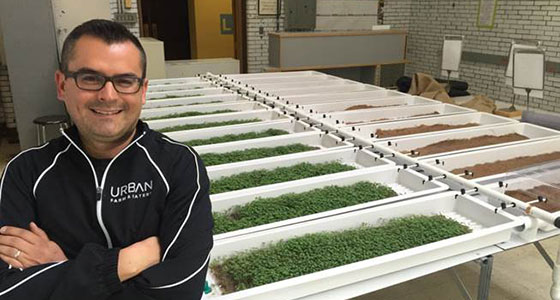
Q: You got your BA in Marketing and then your MBA. What made you decide to get your Culinary Arts Certificate?
Jaime Guerrero: It’s my passion. Even while working in marketing, I have always managed in some way to incorporate food in my life and I love cooking. I have even had a few food business ventures. For example, when I lived in Austin I had a little salsa company where I would make fresh salsa for comedy clubs and deliver them once a week.
Fast forward to Chicago—when I moved here I was getting to know the restaurant scene and I wanted to refine my cooking skills and take it more seriously. I decided to take the plunge and get a certificate from Kendall College. Quickly thereafter, I started an underground dinner series where I would come up with inventive menus—depending on the season—and then invite people over. They would donate money for ingredients, bring their own drinks, and have a good time.
 Q: How did you get the idea to create the Schurz Food Science Lab?
Q: How did you get the idea to create the Schurz Food Science Lab?
Guerrero: As a chef living in Chicago, it is hard to get fresh and local ingredients all year round. The summer is great because I have my garden where I grow a variety of herbs and lettuces, and things like kale, basil, and arugula. But after a few months they’re gone. Then a friend introduced me to indoor farming and I started growing some herbs on a bookshelf in my basement. I was using soil until I learned about hydroponics, which led me to aquaponics—and that just blew my mind. I’m thought, “Man, this is something big. This is something that can revolutionize the way we look at food.”
That’s where I got the idea to create a new restaurant model that is fully sustainable. Take a fast-casual concept and a farmer’s market, but instead of having the farmer’s market source their ingredients from surrounding farms, they would literally be growing the produce right there in the facility. That is what Urban Farm and Eatery is. That’s my vision and what led me in a roundabout way to Schurz.
The Schurz Food Science Lab is my proof of concept. Once I realized the school didn’t have a program in place, I approached the principal with the idea and told him that I would invest a lot of my research, learnings, and money to establish the program.
The first time I introduced the idea to the school’s staff I talked a lot about the bigger picture—droughts, water shortages, and the state of agriculture and how it’s failing. I brought it up to them in that capacity and just said, “Imagine we start this program and put this in front of our kids to help solve. Wouldn’t that be something great?” They were very supportive.
Q: The Lab opened in 2015. What have you learned and how has the program developed?
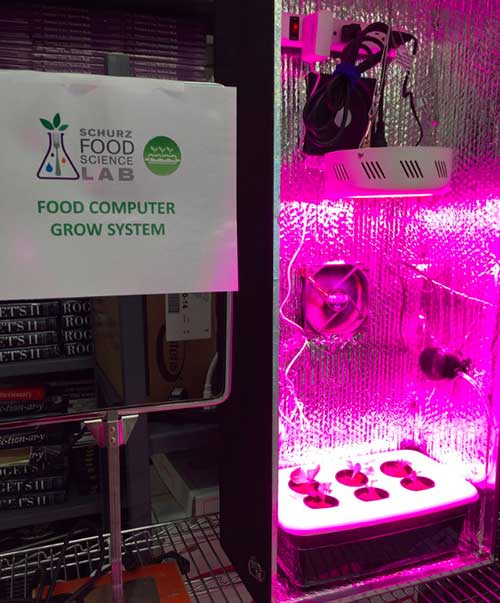
Guerrero: We have learned a lot. We’ve integrated with various departments, including engineering, botany, environmental science, robotics, and the school’s CTE program—their business vocational program—and even other departments like the digital media lab. That’s part of our current rebranding effort—to make it more of a program that combines STEM [Science, Technology, Engineering, and Mathematics] with botany and agriculture arts.
We’re also developing smaller systems that don’t require larger spaces to grow. The technology, software, and hardware allow students to get things up and running quickly, but also—and maybe more importantly—have a connected database so they can share data real time and learn from each other. We’ve partnered with MIT’s Media Lab to bring the food computer [a tabletop-sized, controlled environment agriculture technology platform that uses robotic systems] to Schurz.
Imagine a microcosm of boxes within one school conducting different experiments and sharing the data with each other. Then, imagine expanding it to other schools in Chicago—and Detroit and New York, etc.—and having all of them share information with each other quickly.
Currently, this industry is not as connected and amenable to sharing information as I would like. I am hoping that the more that I go out there and do my research and share my research, I will connect with others and we can learn from each other and then grow from each other.
Q: What’s your role at the lab today?
Guerrero: I am more involved in the administration. I was probably there, in the lab, practically every day during the first year, but I now go about once a week. We have a full-time coordinator now, which is funded by the school, that helps manage the systems and coordinate with departments. I continue to push the program forward and bring it to an evolution that it needs.
We’ve established a program and we have great interest from the kids. We started out by bringing in existing systems, but now we are now at the capacity and have evolved the program to the point where we are starting to build our own systems.
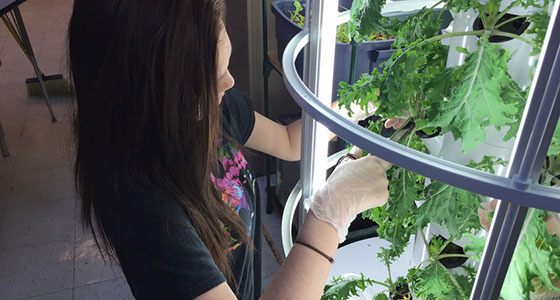
Q: Now that the produce in the lab is being used by the school, do you know if it has had any impact on the food choices the students make?
Guerrero: So, the short answer is that they’re eating it. Quite honestly, it depends on how much we are producing in the farm. At the beginning of the year it is always hard to get new students in and get everything up and running. But once it does, we’re able to focus on and produce things like microgreens that can be mixed into the school salads. At Schurz, 90% of the students eat the salad in some capacity—whether it’s an entrée, a side, or just adding some lettuce to their burger.
While we don’t have a mechanism to track that if the lab has had a direct impact on the students’ food choices, from conversations my coordinator and I have had we hear that kids going home, talk about what they are doing in the lab and sometimes even ask their parents to buy microgreens.
I remember that the surgeon general who visited Chicago two years ago said that he had research that said that kids involved in school gardens end up eating better because they get exposed to things that they weren’t exposed before. And that they’re 20% more likely to ask for that produce at home. Again, we don’t have that research for our own school, but we hope and assume it’s just the same for us once we expose kids to the food.
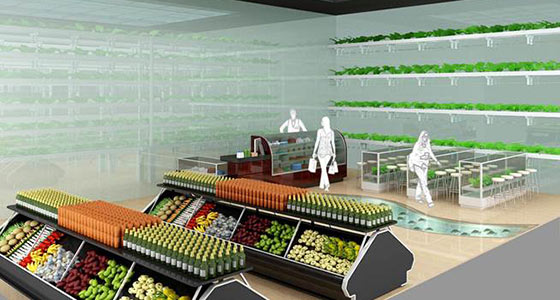
Q: Do you still have plans to open the Urban Farm and Eatery that you envisioned?
Guerrero: Yes. Right now, it’s still in the R&D phase. What I’m trying to do with these smaller systems is to get to a point where I’m just learning through hydroponics about how things grow within a limited space and find better ways to capture that data and share that data.
So, the next step is to continue to do that. We’re also working on more of these food boxes and we’re soon going to make them available to other schools that want to have this type of program and that are willing to share the data as their students continue to learn.
This interview has been edited and condensed for clarity.
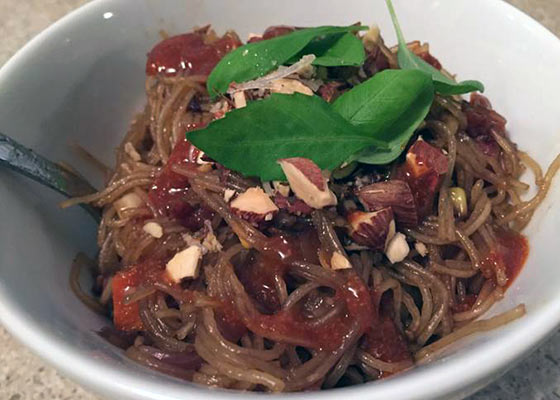
Lemon Basil Pancit
Ingredients:
- 2 lbs. uncooked pancit or vermicelli noodles
- 4 cups sliced celery, carrots, bell peppers, shiitake mushrooms, lemon basil leaves with stems, and green onions
- ½ cup peanut oil
- 1 cup low-sodium soy sauce
- 1 tbsp organic can sugar
- 1 tsp fish sauce
- 1 large yellow onion, chopped
- 6 cloves garlic, crushed
- Whole lemon basil leaves and crushed almonds for garnish
Method:
- Soak the noodles in water for about 5 min or until soft (for a richer flavor, soak noodles in pork broth).
- In a large wok, sauté the garlic and onion in the oil with the fish sauce, soy sauce, and sugar.
- Add the rest of the veggies and cook until tender.
- Add the strained noodles and sauté for 5–10 min until the dish is well mixed.
- Serve in a soup bowl topped with lemon basil leaves and almonds.


